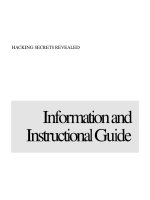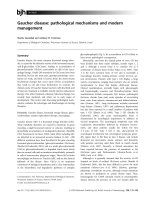Tài liệu HEALTH EDUCATION THROUGH INFORMATION AND COMMUNICATION TECHNOLOGIES FOR K-8 STUDENTS: CELL BIOLOGY, MICROBIOLOGY, IMMUNOLOGY AND MICROSCOPY ppt
Bạn đang xem bản rút gọn của tài liệu. Xem và tải ngay bản đầy đủ của tài liệu tại đây (295.07 KB, 6 trang )
Journal of Theoretical and Applied Information Technology
© 2007 JATIT. All rights reserved.
www.jatit.org
54
HEALTH EDUCATION THROUGH INFORMATION AND
COMMUNICATION TECHNOLOGIES FOR K-8
STUDENTS: CELL BIOLOGY, MICROBIOLOGY,
IMMUNOLOGY AND MICROSCOPY
Yavuz Akbulut & Esra Kurter
Anadolu University
Faculty of Education
Department of Computer Education &
Instructional Technologies
ABSTRACT
Within the context of health education through information and communication technologies (ICT),
software on different aspects and subspecialties of health has been developed by senior students and
lecturers at the Department of Computer Education and Instructional Technologies at Anadolu
University. The study briefly abstracts the evolution of health education, articulates its relationship
with ICT, provides pedagogical implications, and introduces readers to a computer program, which
helps learners develop an understanding of cells, organelles and bacteria along with their structures
and functions.
Keywords: Health Education, Cells, Information and communication technologies, K-8 Software
“A healthy mind rests in a healthy body”
M. Kemal ATATÜRK
INTRODUCTION
Conventional perspectives of education
involve using diverse educational contents and
methods efficiently to accelerate social and
economic development. Besides, instructional
activities should concentrate on a variety of
interrelated notions including effective
communication, creative thinking, and
productivity. In this respect, educational
authorities around the world are obliged to use
the new information and communication
technologies to teach the skills and knowledge
students need in the 21
st
century (UNESCO,
2002).
ICT is employed in several settings.
Health is one of the broadest among those
settings for it involves not only hospitals and
doctors’ offices where the delivery of health
services is realized, but also other areas and their
subspecialties such as biomedical research,
veterinary medicine, dentistry, nursing, allied
health, and public health. Moreover, the use of
DNA and protein sequences to process
biological substances and the application of ICT
to support medical research gave rise to the
subspecialties of biotechnology and medical
informatics (Locatis, 2002). All these
subspecialties increase the health’s share of the
GNP. The public mandate to control cost whilst
improving the quality of service probably lead
authorities to use information technologies for
innovative and efficient solutions (Malato and
Kim, 2004).
It can be proposed that ICT had a place
in health education from the time of Leonardo da
Vinci. Da Vinci’s drawings on anatomical
structures were the first attempts to illustrate
medical knowledge based on observations rather
than speculations, superstitions or religious
beliefs (Locatis, 2002). In 1910, Abraham
Flexner prepared a significant document called
the Flexner Report (1910) which served as a
great reference for health education
professionals since it documented the evolution
of health education and called for the
introduction of scientific rigor to instructional
practices. This report remained unchanged till
the advance of problem-based learning (PBL),
which encouraged applying attained knowledge
to solve problems (Barrows and Tamblyn,
1979). This movement suggested that
educational goals could be better attained
through exposing students to a rich variety of
real and simulated cases. Within the line of PBL,
Journal of Theoretical and Applied Information Technology
© 2007 JATIT. All rights reserved.
www.jatit.org
55
the General Professional Education of The
Physician (GPEP) Report issued in 1984
recommended further curricular reforms in
health education (AAMC, 1984). More
specifically, it called for reduction of lectures,
providing more time for independent study,
requiring active problem solving and application
of information sciences along with computer
technology. The next report issued by the
Association of American Medical Colleges in
1986 echoed the basic themes of the GPEP
Report. Besides, it noted that health
professionals should be kept current, and that
ICT was an important means to sustain lifelong
learning (AAMC, 1986). Benefits of problem-
based learning have been cited in further
research studies. It has been claimed that
students in the PBL programs performed equally
well or better than those in traditional programs
(Locatis, 2002; Vernon and Blake, 1993).
Besides, PBL students had more favorable
attitudes about the teaching method in
comparison to those in the traditional curricula
(Vernon and Blake, 1993). PBL is still very
popular today and ICTs are recognized as
valuable tools supporting the approach. Thus, it
is suggested that anyone interested in
instructional design in health settings should be
aware of the basics of the PBL (Locatis, 2002).
A large variety of settings for education
and training in health could be listed including
the schools of pharmacy, health departments,
public and private hospitals and clinics,
pharmaceutical and biotechnology companies,
professional societies, and health associations.
Two areas of education and training cut across
all above health settings, which are continuing
education for health professionals and skills-
training for all individuals (Locatis, 2002).
Continuing education is required for all health
professionals in order to replace the outdated
procedures with the current ones via workshops,
conferences and other in-service training means.
Skills-training addresses all individuals in the
society and involves basic skills such as first aid
or general health education. In this respect, K-8
institutions host a crucial educational period for
they can equip students with basic skills and
general health knowledge at an early age. Infants
could be considered passive recipients of
medical care; however, growing children should
be allowed to gradually become the active
participant of good health (Nelson, 1979).
Within the framework of health
education for elementary school students,
Nelson (1979) summarizes the objectives of
health education at primary schools. Among
those objectives are making sure that students
feel good about themselves, providing accurate
and concrete information to students about our
bodies, thinking of health as an integral part of
our lives, viewing children as a vital link and
entry to the family, viewing good health as a
right, and recognizing the need for changing
inappropriate behavioral patterns regarding
health. Nelson further suggests that it is
important to present information to children at
the right time with sufficient exercise. Besides,
the information presented must be relevant to the
children involved. Finally, measurable goals
should be established so that the progress will be
observed.
The World Education Forum Report
issued in 2000 presents several research
highlights from the past decade with a particular
emphasis on school health. Among those
highlights, the following two cut across all
health education settings (Vince-Whitman et al.,
2000). First, trained teachers are likely to deliver
more fruitful instruction in terms of students’
health knowledge than those who are not trained
enough. Thus, it is suggested that collaboration
between the education and health sectors to
nurture lifelong learning should be established.
Second, health education is effective when it
uses interactive methods in a skills-based
approach. More specifically, health learning
should emphasize skills-learning over pure
health information delivery. ICT facilitates
skills-learning and practice on health subjects for
it allows the representations and the operations
of health processes or systems through the use of
real-like and efficient means (e.g., animations,
simulations).
Within the framework of health
education through ICT, Anadolu University
lecturers and senior students created several
software environments all of which
concentrating on different aspects and
subspecialties of health education. The current
study is aimed at providing accurate and
concrete information to K-8 students on the
correct functions of our cellular and viral
system. Many attempts have been made to
present and simulate molecular processes in both
cellular and viral systems (Tomita et al., 1999),
some of which presenting the cell division cycle
quite efficiently (Novak and Tyson, 1995;
Tyson, 1991). These environments involve
important details that are quite useful for
undergraduate and graduate students majoring in
both medicine and biomedical sciences. The
present software focuses on teaching the basics
of cell structure, functions of organelles and
structures of some bacteria on a surface level.
The motto will be maintaining the balance
between the children involved and the
information presented as suggested by previous
research (Nelson, 1979), since some details
Journal of Theoretical and Applied Information Technology
© 2007 JATIT. All rights reserved.
www.jatit.org
56
covered in the subject matter can be quite
fatiguing for K-8 students.
The cell structure, functions of
organelles and bacteria are included in the 6
th
grade of the curriculum prepared by the Turkish
Ministry of National Education (MEB, 2006).
Interestingly, students are exposed to chemistry,
physics, biology and health subjects
simultaneously within the framework of Science
and Technology Course. These subjects are not
offered as different courses until students enroll
in high school. Thus, the software environment
presented here is considered a supplementary
material equipping students with the basics of
cell biology, microbiology, immunology and
microscopy within the context of Science and
Technology Course.
SOFTWARE
Sample software environments were
prepared by senior students at the IDT
department within the requirements of the course
BTO 402 - Design, Development and Evaluation
of Educational Software. The software discussed
in this section is adapted from one of those
materials. The aim is to equip 6
th
graders with
the basics of cell structure, organelles, and
structures and functions of the bacteria covering
issues from different aspects of cells including
cell biology, microbiology, immunology and
microscopy. In terms of cell biology, cell models
are provided along with the cell cycle and
apoptosis. Viruses and bacteria were covered in
terms of microbiology. Anatomy of some
malfunctions is provided within the branch of
immunology. Finally, the opportunity to enhance
several microscope images is provided through a
simulation.
Sixth graders are considered at an age
where they could be either experiencing the
concrete operational stage (7-11 years) or the
formal operational stage (11 years and beyond)
(Lin, 2002). Thus, it is important to present the
abstract subject matter with several concrete
elements so that the transmission from the
concrete to abstract becomes easier.
The software was developed with
Macromedia Flash MX 2004. To generate the
annotated illustrations, Photoshop 8.0 was used.
Finally, in order to convert SWF files to FLA,
Sothink SWF Decompiler was used. System
requirements to use the software could be listed
as follows: 133 MHz Intel Pentium processor
with an operating system of Windows 95, 98,
NT 4, 2000 or later; 32 MB RAM; 40 MB of
available disk space; 256-color monitor capable
of 800 x 600 resolution and CD-ROM drive.
While building the framework of the
program, a checklist based on that of Horton was
prepared (Horton, 2000). More specifically, the
steps to be realized were listed as telling learners
about the course, registering them efficiently,
running the course smoothly, providing needed
resources, acknowledging success, gathering
feedback, adding necessary access mechanisms
and helping learners over hurdles.
Learners are told about the content of
the course both on the title page and the
objectives page. Besides, the designer of the
software is also introduced as suggested by
Horton (2000). Students are free to skip the
introduction, which is supported with audio-
visual materials. After the introduction, they are
registered in the login page where they are
expected to sign in through their user names and
passwords or sign up as a new user by providing
their names, user names, passwords, e-mail
addresses and a security question in case they
forget their passwords. The login page is
followed by the welcome page which constitutes
the central of the course to run the material
smoothly. Links to topics to be covered,
objectives page, evaluation page, dictionary to
provide students with needed resources, help
page to assist learners over hurdles, and
copyright page are provided on the welcome
screen.
Figure 1. Links to most submenus are presented
in the welcome page of the program
Students are expected to click one of
the links provided on the welcome page. The
start button is located in the middle of the page.
When students click the start button, they are
transferred to the pre-test page where their prior
knowledge on the subject-matter is evaluated
through 5 multiple-choice questions (Figure 2).
Students are informed about the number
of correct answers they get on the pre-test along
with relevant feedback. They are free to go on
studying even if they get all of the questions
right. On every single page including the pre-
test, students have access to the main page,
Journal of Theoretical and Applied Information Technology
© 2007 JATIT. All rights reserved.
www.jatit.org
57
objectives page, topic list, dictionary and help
menu.
Figure 2. Pre-test screen appears as soon as
students start the course
As students pass through the pre-test,
they see the list of subject matters they need to
cover to finish the course. They are free to
follow either a linear or non-linear order
according to their interests. Each topic is
supported with annotated illustrations (Figure 3).
Figure 3. Each topic is supported with annotated
illustrations
All of the annotated illustrations presented
to the students are based on general design
principles based on research (Levin and Mayer,
1993; Mayer, 2001). More specifically, the
pictures are concentrated where the key ideas are
highlighted. Extraneous descriptions are
minimized both in the text and in the pictures.
Finally, corresponding pictures and text
segments are presented near each other on the
page. On each page, students have an option
named “watch animation” where they are
exposed to short video clips in order for them to
get the gist of the subject-matter with audio-
visual materials.
Students have the links to the
evaluation section on each page. Besides, they
have access to the dictionary where they can find
the definitions of 15 terms covered within the
unit. At the end of the unit, there is also a game
section where students can magnify some of the
bacteria and organelles with a simple electron
microscope simulation.
Figure 4. Students can magnify some bacteria
samples through the electron microscope
Journal of Theoretical and Applied Information Technology
© 2007 JATIT. All rights reserved.
www.jatit.org
58
CONCLUSION
It is claimed that previous studies in
biochemical software environments limited their
models to focus on only one or a few of the
several levels of the hierarchy in cellular
processes (Tomita et al., 1999). Reducing the
gaps among various levels of cell structure is a
challenging task particularly when the
addressees of the software environment are at an
early age for they can have problems in
understanding such complex and sometimes
abstract notions. In this respect, the topic
concreteness was realized to some extent
through animations, videos, annotated
illustrations and simple simulations.
The current software focused on several
aspects of cells including cell biology,
microbiology, immunology and microscopy.
Such a procedure was followed so that the
material would be useful for the curriculum
followed by the Turkish Ministry of National
Education. As mentioned above, the curriculum
covers chemistry, physics, biology and health
within the framework of Science and
Technology course.
The software environment presented
here probably poses several limitations for it was
developed within a short span of time by a small
and novice design team. Thus, it could be
considered a demo for evaluative purposes.
Formative evaluation of the software by
students, teachers and instructional designers is
necessary, so that, the instrument can serve
better each time it is used.
REFERENCES
1. AAMC - Association of American
Medical Colleges. (1984). Physicians
for the twenty-first century.
Washington, DC: Association of
American Medical Colleges.
2. AAMC - Association of American
Medical Colleges. (1986). Medical
education in the information age.
Washington, DC: Association of
American Medical Colleges.
3. Barrows, H.S., & Tamblyn, R. M.
(1979). Problem-based learning in
health sciences education. Bethesda,
MD: National Institute of Health.
4. Flexner, A. (1910). Medical education
in the United States and Canada: a
report to the Carnegie Foundation for
the advancement of teaching. Boston:
Updyke. Reprinted in 1973 by Science
and Health Publications, Bethesda, MD.
5. Horton, W. (2000). Designing web-
based training. New York: John Wiley
and Sons, Inc.
6. Levin, J. R., & Mayer, R. E. (1993).
Understanding illustrations in text, in
B.K. Britton, A. Woodward, and M.
Binkley (Eds.), Learning from
Textbooks: Theory and practice.
Hillsdale, NL: Erlbaum.
7. Lin, S. (2002). Piaget's developmental
stages. In B. Hoffman (Ed.),
Encyclopedia of educational
technology. [On-line], Available:
/>art.htm
8. Locatis, C. (2002). Instructional design
and technology in health care. In R. A.
Reiser, and J. V. Dempsey (Eds.),
Trends and issues in instructional
design and technology (pp.225-238).
New Jersey, USA: Upper Saddle River.
9. Malato, L.A., & Kim, S. (2004). End-
user perceptions of a computerized
medication system: Is there resistance
to change? Journal of Health and
Human Services Administration, 27,
34-55.
10. Mayer, R. E. (2000). Multimedia
Learning, Cambridge, UK: Cambridge
University Press.
11. MEB - Turkish Ministry of National
Education (2006). Yeni öğretim
programlari”. [On-line], Available:
/>s.php?name=Downloads&d_op=viewd
ownload&cid=18
12. Nelson, H. M. (1979). Health education
in school and preschool settings. In P.
M. Lazes (Ed.), The handbook of health
education (pp. 37-51). Germantown,
Maryland, USA: Aspen Systems
Corporation.
13. Novak, B., & Tyson, J. J. (1995).
Quantitative analysis of a molecular
model of mitotic control in fission
yeast. Journal of Theoretical Biology,
173, 283-305.
14. Tomita, M., Hashimoto, K., Takahashi,
K., Shimizu, T., Matsuzaki, Y.,
Miyoshi, F., Saito, K., Tanida, S., Yugi,
K., Venter, J.C., & Hutchison, C.
Journal of Theoretical and Applied Information Technology
© 2007 JATIT. All rights reserved.
www.jatit.org
59
(1999). E-CELL: Software environment
for whole cell simulation.
Bioinformatics, 15,72-84.
15. Tyson, J. J. (1991). Modeling the cell
division cycle: cdc2 and cycling
interactions. Proceedings of the
National Academy of Sciences, pp.
7328-7332.
16. UNESCO. (2002). Information and
communication technologies in teacher
education: A planning guide. [On-line],
Available:
/>001295/129533e.pdf
17. Vernon, D., & Blake, R. (1993). Does
problem-based learning work? A meta-
analysis of evaluative research.
Academic Medicine, 68, 550-563.
18. Vince-Whitman, C., Aldinger, C.,
Levinger, B., & Birdthistle, I. (2000).
EFA 2000 assessment: Thematic study
on school health and nutrition. Paris:
UNESCO.









